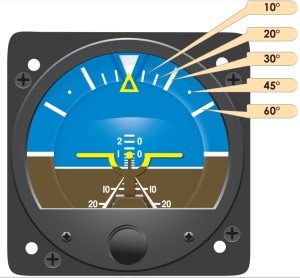
An attitude indicator is an important type of flight instrument. Located in the cockpit — as part of the six-pack of flight instruments — it reveals the airplane’s position relative to the Earth’s horizon. Whether you’re flying a turbofan or turboprop airplane, it probably features an attitude indicator. Using this essential flight instrument, you can check your airplane’s attitude.
Understanding Attitude
To better understand the purpose of an attitude indicator and how it works, you must familiarize yourself with attitude. When used in the context of flight, the term “attitude” refers to the angular difference between an airplane’s axis — typically the airplane’s pitch and roll axis — and the Earth’s horizon.
The Basics of Attitude Indicators
Attitude indicators are flight instruments that provide information about an airplane’s attitude. Pilots can refer to their airplane’s attitude indicator to see whether the airplane is ascending, descending or banking.
While most people associate them with airplanes, attitude indicators aren’t limited to airplanes; they are found on spacecraft as well. Attitude indicators used on spacecraft are known as Flight Director Attitude Indicators (FDAIs). They reveal the spacecraft’s yaw, pitchm roll and orbit relative to a fixed point of reference.
How Attitude Indicators Work
Most attitude indicators rely on a gyroscope to provide attitude-related flight information. They are connected to a gyroscope that spins during flight. Attitude indicators work will then reveal the angular difference between an airplane’s axis and the Earth’s horizon in real time.
Attitude is measured in degrees. At the top of a typical attitude indicator is a set of reference lines, each of which represents 10 degrees. As the airplane climbs, descends or banks, the attitude indicator will shift. Pilots can then refer to these reference lines to determine the airplane’s attitude.
Vacuum-Driven vs Electronic Attitude Indicators
There are vacuum-driven attitude indicators, and there are electronic attitude indicators. Vacuum-driven attitude indicators are powered by a stream of air in a closed-off vacuum system. Electronic attitude indicators, in comparison, are digital. Both types rely on a gyroscope, but electronic attitude indicators feature a digital display that’s not found in their vacuum-driven counterparts.
In Conclusion
An attitude indicator is an important flight instrument in modern aviation. It provides pilots with real-time information about the airplane’s attitude. Using this information, pilots can easily see the airplane’s axis relative to the Earth’s horizon. Whether vacuum-driven or electronic, attitude indicators use a gyroscope to collect and reveal this information about the airplane’s flight dynamics.



